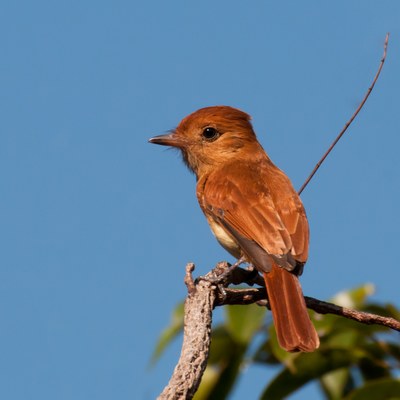Forest Bird Community is endangered in South America

Casiornis rufus, one of the endangered birds in the Gran Chaco.
Photo: Leandro Macchi
Only seven percent of Argentina’s largest tropical dry forest presents woody cover levels above the threshold to host the forest bird community of the dry Chaco. A study, led by researchers at Humboldt-Universität zu Berlin (HU), used a novel approach to combine species-level (field data of bird species) and ecosystem-level (satellite-based, continuous woody cover maps) surrogates for understanding biodiversity patterns and threats related to changes in forest cover. The study finds that high quality forest for bird species are scarce in the dry Chaco; while most of the area (68 percent) had woody cover levels with incremental declines in forest bird species, and 25 percent of the study area had woody cover levels below the minimum to host the forest bird community.
The study, led by Dr. Leandro Macchi from HU Berlin’s Geography Department working now at the Argentinean Scientific and Technical research Council (CONICET), evaluated how forest birds decline abruptly when certain thresholds of woody cover are crossed. He emphasizes, “The Gran Chaco has become a global deforestation hotspot due to agricultural expansion to produce beef and soybeans, which in turn are used to feed pigs, chicken and cows in places like Europe and China. Moreover, remaining areas normally characterized as forest experienced a long history of human use including wood extraction, charcoal production (also exported to Europe), and subsistence livestock activities that degraded pristine forest and their value as habitat for biodiversity.”
The study identified areas where halting deforestation and forest degradation (e.g., by excluding forest grazing) provide opportunities for the conservation of forest bird communities. Also, given that only a small portion of the study area was below critical thresholds it shows that the window of opportunity to prevent woody cover to cross undesirable thresholds for forests bird communities remains open.

Parula pitiayumi. Photo: N. Atanas
It suggests that silvopastures, as currently implemented push bird communities very close to critical thresholds, leading to the loss or reduction of many forest species, and are thus unlikely to be resilient or sustainable. However, implementing silvopastural systems with a higher shrub and tree cover (i.e., more than 38 percent total woody cover) has potential to support stable forest bird communities, and would thus be a promising ‘wildlife friendly’ management option at the farm scale. Importantly, producing meat is a known inefficient way to use land, water and resources, and a major drive behind the changes in natural habitat in developing areas, as the Chaco.
The study was based on an extensive data set of 167 bird species provided by the Instituto de Ecología Regional (Argentina) and woody cover satellite-derived maps develop by researchers at the Conservation Biogeography Lab of the HU led by Prof. Dr. Tobias Kümmerle.
Publication
Leandro Macchi, Matthias Baumann, Hendrik Bluhm, Matthew Baker, Christian Levers, H. Ricardo Grau, Tobias Kuemmerle: Thresholds in forest bird communities along woody vegetation gradients in the South American Dry Chaco, Journal of Applied Ecology, https://doi.org/10.1111/1365-2664.13342
Contact
Dr. Leandro Macchi
Institut für Geographie
macchile@hu-berlin.de
Boris Nitzsche
Stellvertretender Pressesprecher
Phone: 030 2093 2945
boris.nitzsche@hu-berlin.de
